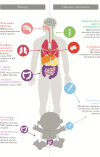The Intestinal Microbiome in Infectious Diseases: The Clinical Relevance of a Rapidly Emerging Field
- PMID: 28852682
- PMCID: PMC5570093
- DOI: 10.1093/ofid/ofx144
The Intestinal Microbiome in Infectious Diseases: The Clinical Relevance of a Rapidly Emerging Field
Abstract
The field of infectious disease is undergoing a paradigm shift as the intestinal microbiome is becoming understood. The aim of this review is to inform infectious disease physicians of the potential relevance of the intestinal microbiome to their practice. We searched Medline using both index and text words relating to infectious diseases, microbiome, and probiotics. Relevant articles published up through 2017 were reviewed within Rayyan. The review illustrates pathophysiologic concepts linking the microbiome and infectious diseases; specifically, the intestinal microbiome's relevance to early immune development, the microbiome and enteric infections, the microbiome's relevance in compromised hosts, and antimicrobial resistance. Within each subject, there are specific examples of diseases and at-risk patient populations where a role for the microbiome has been strongly established. This provides an overview of the significance of the intestinal microbiome to microbiology, pediatric and adult infectious diseases with an underpinning of concepts useful for the practicing clinician.
Keywords: immunology; infectious diseases; intestinal microbiome; microbiology.
Figures

Similar articles
-
A longitudinal assessment of host-microbe-parasite interactions resolves the zebrafish gut microbiome's link to Pseudocapillaria tomentosa infection and pathology.Microbiome. 2019 Jan 24;7(1):10. doi: 10.1186/s40168-019-0622-9. Microbiome. 2019. PMID: 30678738 Free PMC article.
-
The clinical relevance of the microbiome when managing paediatric infectious diseases-Narrative review.Acta Paediatr. 2021 Feb;110(2):441-449. doi: 10.1111/apa.15578. Epub 2020 Nov 10. Acta Paediatr. 2021. PMID: 32961592 Review.
-
Studying the Microbiome: "Omics" Made Accessible.Semin Liver Dis. 2016 Sep;36(4):306-311. doi: 10.1055/s-0036-1594008. Epub 2016 Dec 20. Semin Liver Dis. 2016. PMID: 27997969 Review.
-
Implication of the intestinal microbiome in complications of cirrhosis.World J Hepatol. 2016 Sep 28;8(27):1128-1136. doi: 10.4254/wjh.v8.i27.1128. World J Hepatol. 2016. PMID: 27721918 Free PMC article. Review.
-
Interactions of the microbiome with pharmacological and non-pharmacological approaches for the management of ageing-related musculoskeletal diseases.Ther Adv Musculoskelet Dis. 2021 Apr 20;13:1759720X211009018. doi: 10.1177/1759720X211009018. eCollection 2021. Ther Adv Musculoskelet Dis. 2021. PMID: 34104230 Free PMC article. Review.
Cited by
-
The Gut-liver Axis in Immune Remodeling: New insight into Liver Diseases.Int J Biol Sci. 2020 Jun 23;16(13):2357-2366. doi: 10.7150/ijbs.46405. eCollection 2020. Int J Biol Sci. 2020. PMID: 32760203 Free PMC article. Review.
-
Altered Patterns of Compositional and Functional Disruption of the Gut Microbiota in Typhoid Fever and Nontyphoidal Febrile Illness.Open Forum Infect Dis. 2020 Jun 26;7(7):ofaa251. doi: 10.1093/ofid/ofaa251. eCollection 2020 Jul. Open Forum Infect Dis. 2020. PMID: 32715018 Free PMC article.
-
Measuring Environmental Exposure to Enteric Pathogens in Low-Income Settings: Review and Recommendations of an Interdisciplinary Working Group.Environ Sci Technol. 2020 Oct 6;54(19):11673-11691. doi: 10.1021/acs.est.0c02421. Epub 2020 Sep 9. Environ Sci Technol. 2020. PMID: 32813503 Free PMC article. Review.
-
Microbiome Dynamics: A Paradigm Shift in Combatting Infectious Diseases.J Pers Med. 2024 Feb 18;14(2):217. doi: 10.3390/jpm14020217. J Pers Med. 2024. PMID: 38392650 Free PMC article. Review.
-
Prebiotic potential of green banana flour: impact on gut microbiota modulation and microbial metabolic activity in a murine model.Front Nutr. 2023 Oct 31;10:1249358. doi: 10.3389/fnut.2023.1249358. eCollection 2023. Front Nutr. 2023. PMID: 38024360 Free PMC article.
References
-
- Gordon JI. Honor thy gut symbionts redux. Science 2012; 336:1251–3. - PubMed
-
- Fraher MH, O’Toole PW, Quigley EM. Techniques used to characterize the gut microbiota: a guide for the clinician. Nat Rev Gastroenterol Hepatol 2012; 9:312–22. - PubMed
-
- Baquero F, Nombela C. The microbiome as a human organ. Clin Microbiol Infect 2014; 18:2–4. - PubMed
-
- Lynch SV, Pedersen O. The human intestinal microbiome in health and disease. N Engl J Med 2016; 375:2369–79. - PubMed
Publication types
LinkOut - more resources
Full Text Sources
Other Literature Sources

